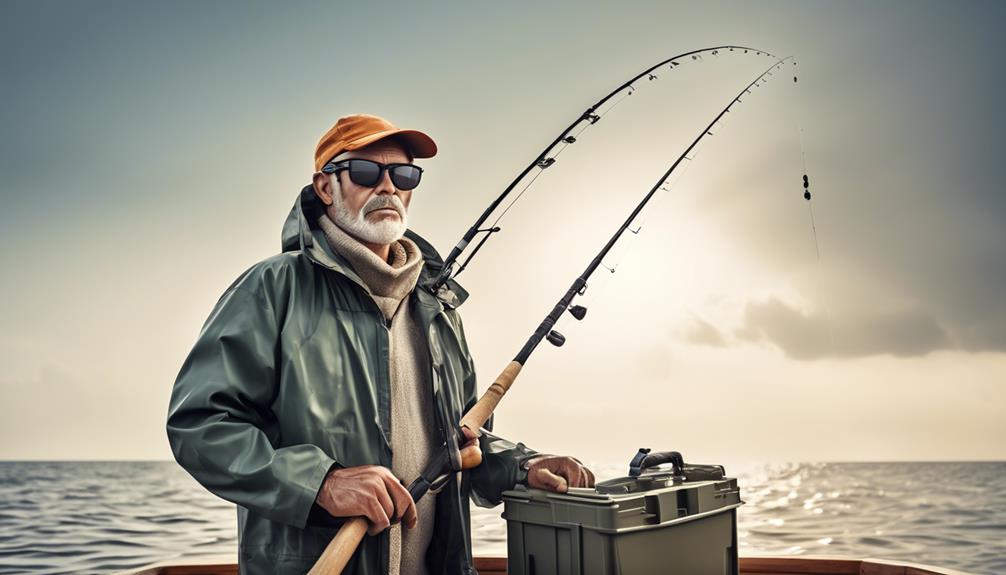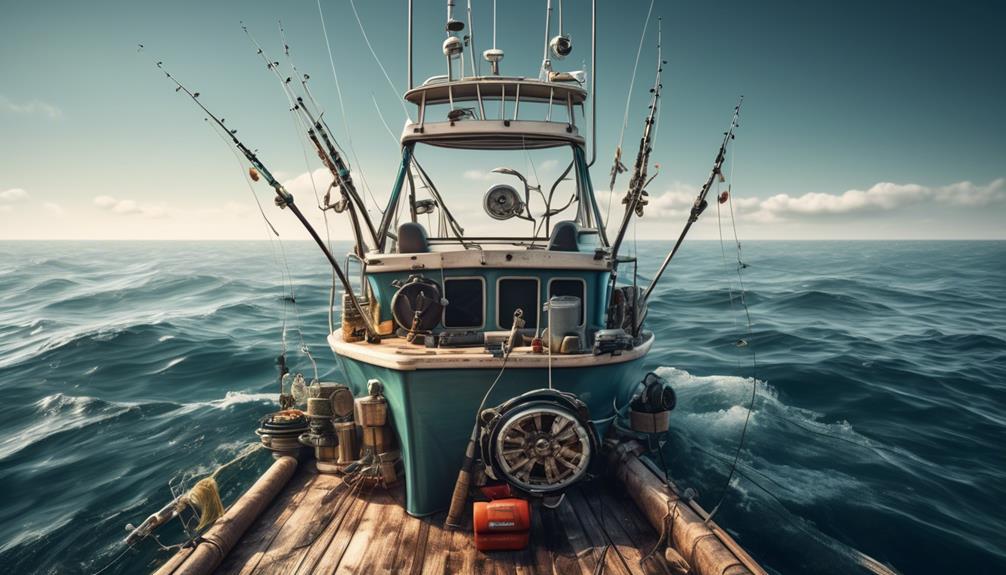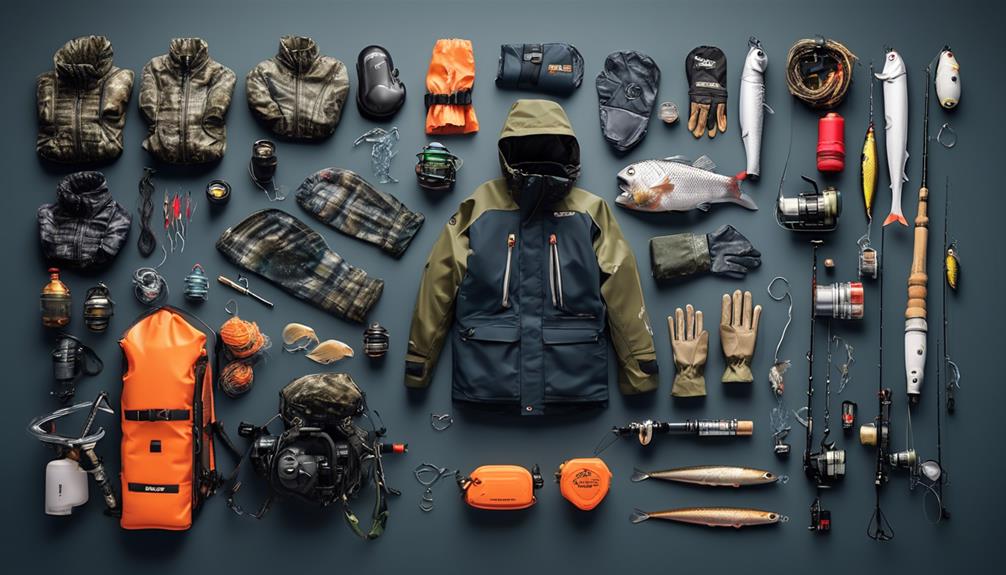Ever wondered if having the right tackle and gear can truly make a difference in your deep sea fishing experience? From the strength of your line to the effectiveness of your lures, the equipment you choose can greatly impact your chances of a successful catch.
But how do you know which essentials are truly worth investing in? Let's explore the key components that can elevate your deep sea fishing game and ensure a more rewarding expedition.
Rods and Reels
To make the most of your deep sea fishing experience, you need a reliable rod and reel combination that can handle the demanding conditions of the open ocean. When it comes to rods and reels, maintenance is key to ensuring they perform at their best.
After each fishing trip, rinse your equipment with fresh water and thoroughly dry it to prevent corrosion. Inspect the rods for any signs of damage and replace worn-out or damaged parts promptly. Reels should be cleaned and lubricated regularly to keep them functioning smoothly. Additionally, store your rods and reels in a cool, dry place to prevent rust and deterioration.
When it comes to the best brands for deep sea fishing rods and reels, several stand out for their quality and durability. Shimano, Penn, and Daiwa are renowned for producing top-notch equipment that can withstand the rigors of deep sea fishing. Their products are designed to handle the powerful pulls of large ocean fish and the corrosive nature of saltwater. These brands offer a range of options to suit different preferences and budgets, ensuring that you can find the perfect rod and reel for your deep sea fishing adventures.
Lines and Leaders
After caring for your rods and reels, the next essential component for deep sea fishing is selecting the right lines and leaders to handle the powerful pulls of large ocean fish.
When it comes to lines, braided lines are popular for deep sea fishing due to their strength, thin diameter, and minimal stretch, allowing you to feel even the slightest nibble. Fluorocarbon lines are another excellent choice as they're virtually invisible underwater and resistant to abrasion, ideal for targeting finicky fish in deep waters.
When it comes to leaders, it's crucial to use a heavier and more durable material than your main line to prevent fish with sharp teeth or rough mouths from breaking the line. Monofilament leaders are a great option for their flexibility and shock absorption, while fluorocarbon leaders offer low visibility and high abrasion resistance.
Proper knot tying is essential for securing your hooks, lures, and connections. The improved clinch knot and palomar knot are reliable and straightforward knots for securing hooks, while the double uni knot is excellent for joining lines of different diameters.
Regular line maintenance is also crucial to ensure the lines' integrity. Check for nicks, abrasions, or weak spots and replace the line if necessary to prevent break-offs during a big catch.
Hooks and Rigs
Select the appropriate hooks and rigs based on the type of fish you're targeting and the fishing conditions you'll encounter.
Bait presentation is crucial in deep sea fishing, and the right hook and rig can make a significant difference. When targeting larger predatory fish such as marlin or tuna, consider using sturdy circle hooks to increase hook-up rates and minimize injury to the fish.
For smaller or finicky species like snapper or grouper, a well-presented live or cut bait on a snelled hook rig can entice bites. Understanding fish behavior and angling techniques is key to choosing the right rig.
For instance, if you're bottom fishing for species that dwell near the ocean floor, a dropper loop rig can keep the bait close to the bottom while minimizing tangles. In contrast, when targeting pelagic species that roam the open water, a wire leader rig with a flashy lure can attract their attention.
Knot tying is another essential skill when it comes to hooks and rigs. Ensure that you can tie strong and reliable knots, such as the improved clinch knot or the palomar knot, to secure your hooks and rigs effectively. A poorly tied knot can result in lost fish and frustration.
Additionally, when selecting rigs, consider the visibility of the rig components. For clearer water conditions, using fluorocarbon leaders and lighter, less obtrusive rigs can increase the chances of a bite. In murkier waters, a heavier and more visible rig may be necessary to attract attention.
Mastering the art of bait presentation, knot tying, and understanding fish behavior will greatly enhance your deep sea fishing experience.
Lures and Baits
When choosing lures and baits for deep sea fishing, consider the natural prey of your target fish to increase your chances of a successful catch. Understanding the feeding habits of the fish you're targeting will help you select the most effective bait or lure. Here are some essential tips for bait selection and trolling techniques:
- Research the Prey: Before heading out, research the natural prey of the fish you aim to catch. This will help you choose lures or baits that closely resemble their natural food source, increasing the likelihood of a strike.
- Live Bait vs. Artificial Lures: Live bait such as squid, sardines, or mullet can be highly effective for attracting deep sea fish due to their natural movements and scents. On the other hand, artificial lures come in various shapes, sizes, and colors to mimic different types of prey. Experimenting with both live bait and artificial lures can help you determine the most effective option for your target fish.
- Matching the Hatch: During certain times of the year, specific types of baitfish may be more prevalent in the area. Matching your bait or lure to the prevalent baitfish can significantly improve your chances of a successful catch.
- Trolling Techniques: Trolling involves dragging bait or lures behind a moving boat. Varying your trolling speed and using diving lures at different depths can help you cover more ground and increase your chances of enticing a strike from deep sea fish.
Tools and Accessories
To enhance your deep sea fishing experience, ensure you have the essential tools and accessories that complement your bait selection and trolling techniques. Tackle boxes are indispensable for organizing your gear. Invest in a sturdy, waterproof tackle box with adjustable dividers to keep your lures, hooks, and weights neatly sorted.
Additionally, maintenance tips are crucial for keeping your tools and accessories in top condition. Regularly rinse your reels with freshwater to remove salt and sand, and lubricate moving parts to prevent corrosion.
Mastering a few essential fishing knots is also vital. Learn the improved clinch knot for securing your line to the hook, and the double uni knot for connecting lines of different weights or materials. These knots will ensure your tackle stays secure during intense battles with deep sea fish.
Moreover, cleaning supplies are often overlooked but are essential for maintaining your equipment. Pack a small brush to remove debris from your reels and a corrosion inhibitor to protect metal parts from saltwater exposure.
Safety Equipment
Ensure you have equipped yourself with reliable safety gear before embarking on your deep sea fishing expedition. Deep sea fishing can be exhilarating, but it's crucial to prioritize safety. Here are the essential safety items you need to have on board:
- Life jackets: Every person on the boat should have access to a properly fitting life jacket. In the event of an emergency, life jackets can be life-saving, especially in rough seas.
- Emergency flares: It's important to have a set of emergency flares on board. These can be used to signal for help in case of an emergency or when communication devices fail.
- First aid kits: Accidents can happen, so having a well-stocked first aid kit is essential. Your kit should include items to treat cuts, burns, and other injuries that may occur during your trip.
- Communication devices: Whether it's a VHF radio, satellite phone, or EPIRB (Emergency Position Indicating Radio Beacon), having reliable communication devices is vital. They can be used to call for help, check weather conditions, or stay updated on fishing regulations.
Additionally, always stay informed about fishing regulations and adhere to them. Keep an eye on weather forecasts and be prepared for any changes in weather conditions. By having the right safety equipment and being prepared for emergencies, you can ensure a safer and more enjoyable deep sea fishing experience.
Clothing and Gear

As you prepare for deep sea fishing, your choice of clothing and gear will play a crucial role in ensuring your comfort and safety on the water. Sun protection is essential for long hours spent under the sun. Opt for lightweight, long-sleeved shirts and pants to shield your skin from harmful UV rays. Additionally, don't forget to wear a wide-brimmed hat and polarized sunglasses to protect your face and eyes. Waterproof footwear is also a must-have. Look for deck shoes or boots that provide good traction on wet surfaces and will keep your feet dry and comfortable throughout the trip.
When it comes to sun protection, consider investing in clothing made with UPF (Ultraviolet Protection Factor) fabric, which offers an extra layer of defense against the sun's rays. This type of clothing is designed to block a significant amount of UV radiation, providing you with added protection compared to regular clothing.
As for waterproof footwear, ensure that they aren't only waterproof but also quick-drying to keep your feet comfortable and prevent blisters.
Storage and Organization
Consider organizing your fishing equipment and personal items into separate compartments or bags to ensure easy access and prevent clutter on the boat. Proper storage solutions and gear management are essential for a successful and enjoyable deep sea fishing trip. Here are some tips to help you keep your gear organized and easily accessible:
- Tackle boxes: Invest in quality tackle boxes with multiple compartments to keep your lures, hooks, sinkers, and other small items neatly organized. This won't only save you time when searching for specific tackle but also prevent tangles and damage to your gear.
- Gear bags: Use gear bags to store larger items such as reels, spools of line, and tools. Look for bags with various pockets and compartments to keep everything in its place and avoid a jumble of equipment.
- Waterproof containers: Utilize waterproof containers to protect electronic devices, documents, and personal items from water damage. It's crucial to keep your valuables safe and dry during the fishing trip.
- Personal organization: Consider using a separate bag or pouch for personal items such as sunscreen, sunglasses, snacks, and first aid supplies. This will ensure that these essentials are readily available when needed, without having to rummage through your fishing gear.
Frequently Asked Questions
What Are the Best Techniques for Finding and Attracting Deep Sea Fish?
To attract deep sea fish, try using deep sea baiting techniques and deep sea chumming methods.
Baiting involves using live or cut fish as bait, while chumming entails dispersing fish food to attract fish.
Experiment with different bait and chum types to see what works best in your location.
Remember to be patient and persistent, as it may take some time to find the right combination that attracts the deep sea fish you're targeting.
How Can I Properly Maintain and Store My Fishing Equipment to Ensure Longevity?
To properly maintain and store your fishing equipment for longevity, it's essential to clean and dry your gear after each use.
Proper storage means keeping your equipment in a cool, dry place to prevent rust and deterioration.
Inspect your gear regularly for any signs of wear and tear, and replace any worn-out parts.
Are There Any Specific Regulations or Restrictions for Deep Sea Fishing in Different Locations?
When deep sea fishing, it's crucial to know the specific regulations and restrictions in different locations. Enforcement of permits, quotas, and conservation management varies, so always check the local rules.
Some areas may have restrictions on certain species or fishing methods to protect the marine environment. Being aware of these regulations ensures sustainable fishing practices and helps preserve the marine ecosystem for future generations.
What Are Some Common Challenges or Obstacles to Be Aware of When Deep Sea Fishing?
When deep sea fishing, be prepared for weather conditions and equipment maintenance. Weather changes rapidly, so stay updated for safety. Rough seas can make fishing challenging, so brace yourself.
Equipment maintenance is crucial, ensure your gear is in top condition. Keep an eye on your gear's functionality. Stay alert to avoid obstacles like drifting debris.
How Can I Prepare for Potential Emergency Situations While Out on a Deep Sea Fishing Trip?
When deep sea fishing, it's crucial to prepare for potential emergency situations. Safety measures like checking the weather forecast, carrying emergency supplies, and having a communication plan can make a big difference.
Ensure your boat is equipped with necessary safety gear and that you have a clear understanding of emergency protocols. Being prepared for emergencies can help you stay safe and enjoy your deep sea fishing trip to the fullest.
Conclusion
Now that you have your tackle and gear essentials sorted, you're ready to hit the open sea and reel in some big catches.
Remember to stay safe, dress for the weather, and keep your gear organized for a successful deep sea fishing adventure.
With the right equipment and preparation, you'll be ready to tackle whatever the deep sea has to offer.
Happy fishing!



